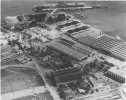This weekend was spent at NAS Oceana, MASTER JET BASE. We've all flown into airfields without knowing the historical significance of the why they were named as such. I thought it would be interesting to share and re-live some of the great and not-so-great Naval Air Stations and the history behind them.
I'll start with NAS Oceana.

Naval Auxiliary Air Station (NAAS) Oceana was commissioned in August 17, 1943. Because it was growing, on April 1, 1952, SECDEF re-named it Naval Air Station Oceana. On June 4, 1957, it was named Apollo Soucek Field after Vice Admiral Apollo Soucek.
Vice Admiral Apollo Soucek was a Naval Aviator, a Test Pilot in the 1920s, a high altitude record holder in 1929 & 1930 (seaplane: 38,560 feet / landplane: 43,166 feet), first CO of the Midway-class USS Franklin D. Roosevelt (CVB 42) in 1945, Commander of Carrier Division Three from 1952-1953 and Commander Task Force 77. From 1953-1955 he was in charge of the Navy's Bureau of Aeronautics from 1953-1955.
-ea6bflyr
I'll start with NAS Oceana.

Naval Auxiliary Air Station (NAAS) Oceana was commissioned in August 17, 1943. Because it was growing, on April 1, 1952, SECDEF re-named it Naval Air Station Oceana. On June 4, 1957, it was named Apollo Soucek Field after Vice Admiral Apollo Soucek.
Vice Admiral Apollo Soucek was a Naval Aviator, a Test Pilot in the 1920s, a high altitude record holder in 1929 & 1930 (seaplane: 38,560 feet / landplane: 43,166 feet), first CO of the Midway-class USS Franklin D. Roosevelt (CVB 42) in 1945, Commander of Carrier Division Three from 1952-1953 and Commander Task Force 77. From 1953-1955 he was in charge of the Navy's Bureau of Aeronautics from 1953-1955.
-ea6bflyr


 Ah... Cecil, the lap of luxury.
Ah... Cecil, the lap of luxury.



